Can Sweatcoin, with 100 million users, become the next hit in the traditional fitness app chain reform?
Author: Wuhai
Following the rise in price and popularity of Stepn, a number of blockchain startup projects themed around fitness have gained traction, among which Sweatcoin is one. On September 13, exchanges such as OKX, FTX, and Kucoin successively launched Sweatcoin's token, Sweat, which attracted market attention with a return of 1000% compared to its public offering price.
Sweatcoin is built on the Near blockchain, with investment from the NEAR Foundation. On July 28, Sweatcoin developer Sweat Economy raised $13 million to seek to deepen its web3 capabilities. This round of financing was led by Spartan Capital, with participation from Electric Capital, OKX Blockdream Ventures, Goodwater Capital, and GSR Capital. On September 4, the public offering platform Daomaker launched the public sale round for Sweatcoin, with a total quota of $2 million.
Established in 2015, it has jumped to the top of the health app download list in the first half of the year
Sweatcoin is a health and fitness application that, before integrating blockchain, rewarded users with "sweatcoins" for their in-app activities, referred to as "Airmiles for steps," which can be exchanged for brand products, digital services, and charitable donations. Its developer is Sweat Economy. Founded in 2015, Sweat Economy's mission is to promote healthier living by encouraging people to exercise more.
Now, Sweat Economy focuses on leveraging numerous opportunities that combine blockchain and Web3 to bring more rewards to its users, having launched SWEAT and the accompanying Sweat Wallet application in 2022.
According to Apptopia, in the first half of 2022, Sweatcoin was the most downloaded health and fitness app in the world, with downloads reaching 34 million, marking the app's first entry into the rankings.
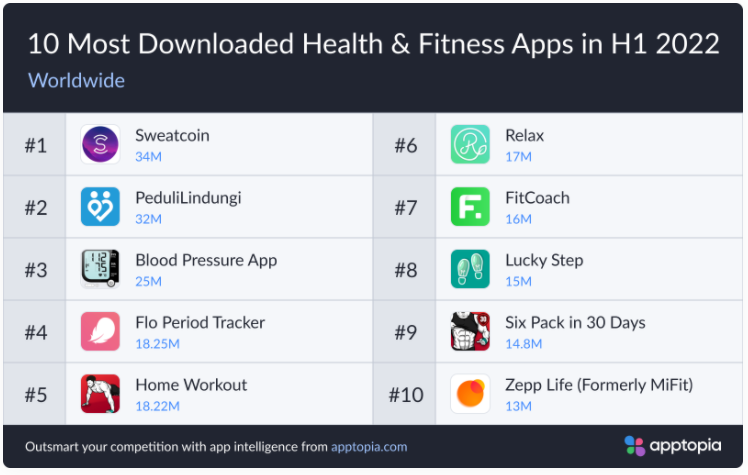
According to official data, since the first half of 2022, Sweatcoin's global downloads have doubled; by early June 2022, its total user count reached 100 million. The significant increase in Sweatcoin's data indicates that the measures to integrate blockchain technology and enhance cryptocurrency incentives are effective.
Team
According to LinkedIn information, Oleg Fomenko is the co-founder and CPO of Sweatcoin. Since graduating from university in 1993, he has held important positions in several companies, including PepsiCo, Coca-Cola, and British Telecom, and has been involved in founding Sweatcoin since 2014.
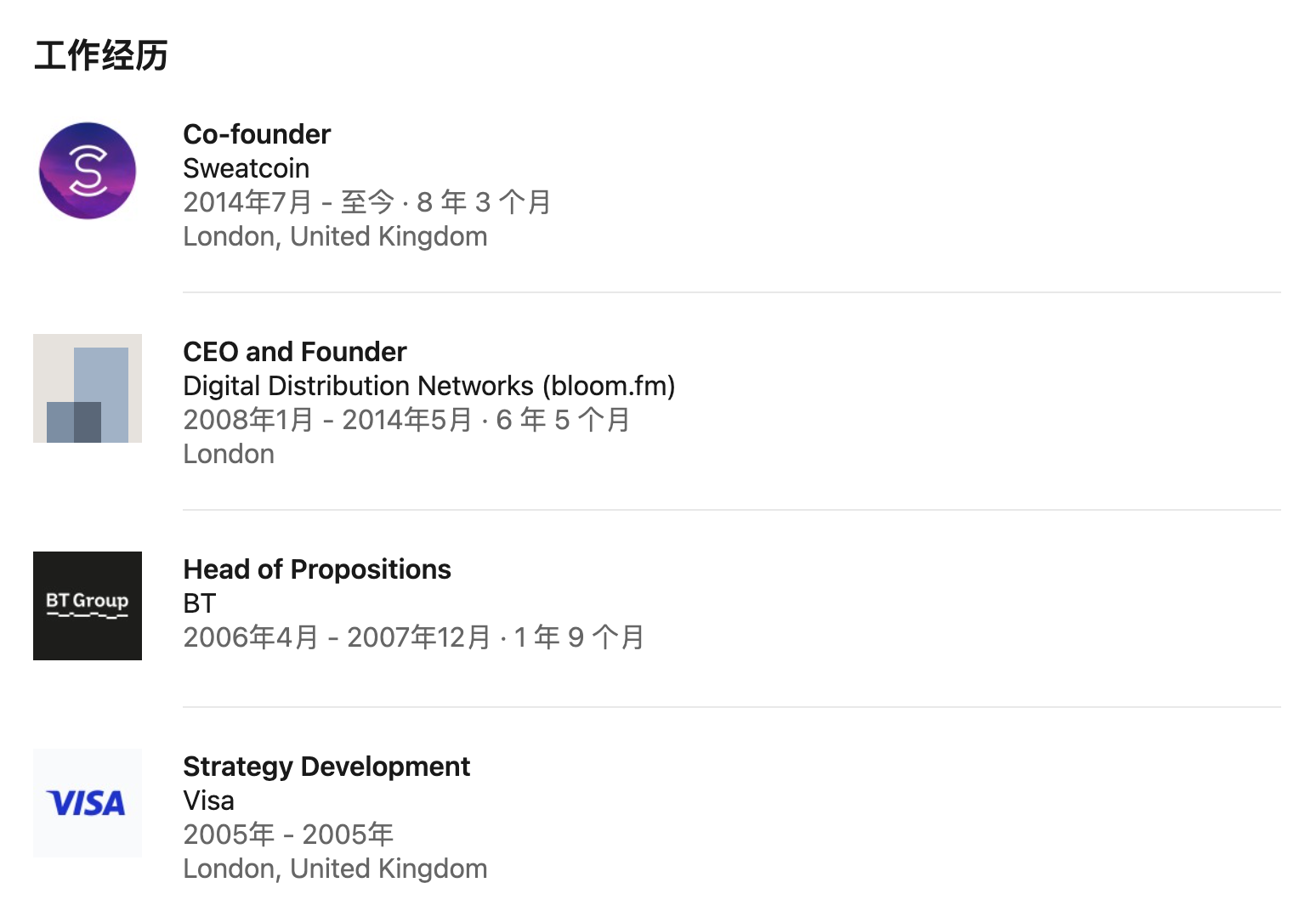
Anton Derlyatka is the co-founder and CEO of Sweatcoin. He was a partner at a venture capital firm focused on future work and fitness skills and has held executive positions at Reebok, Korn Ferry, and PepsiCo.
Egor Khlemev is the co-founder and CTO of Sweatcoin, having co-founded several tech companies.
It can be seen that before building Sweatcoin, team members had multiple entrepreneurial experiences and executive backgrounds, and Sweatcoin has been established for eight years, which indirectly suggests the team's long-term vision and passion for their work.
Economic Model
Compared to Stepn's dual-token model, Sweatcoin has only one token, SWEAT, which is entirely minted through users walking and exercising, with a total issuance of 25.5 billion tokens. The team has already burned 4.5 billion tokens, leaving a current issuance of 21 billion tokens.
Of this, 27.71% belongs to the foundation, released linearly over four years; 25% is allocated for locked airdrops, released linearly over two years, followed by a daily release of 525 million tokens for a period of two years; 22% belongs to Sweatcoin LLC, locked for one year, then released linearly over three years; 10.92% belongs to the team and advisors, locked for one year, then released linearly over three years; 7.02% belongs to the ecosystem, fully released upon launch; 3.33% is from the private placement round, priced at $0.014, raising $10 million, locked for one year, and released linearly over three years; 2.68% is from the seed round, priced at $0.012, raising $6.69 million, locked for one year, and released linearly over three years; 1.33% is from the public offering round, priced at $0.0071, with 35% released at launch, 35% released in the 9th month, and 30% released in the 18th month.
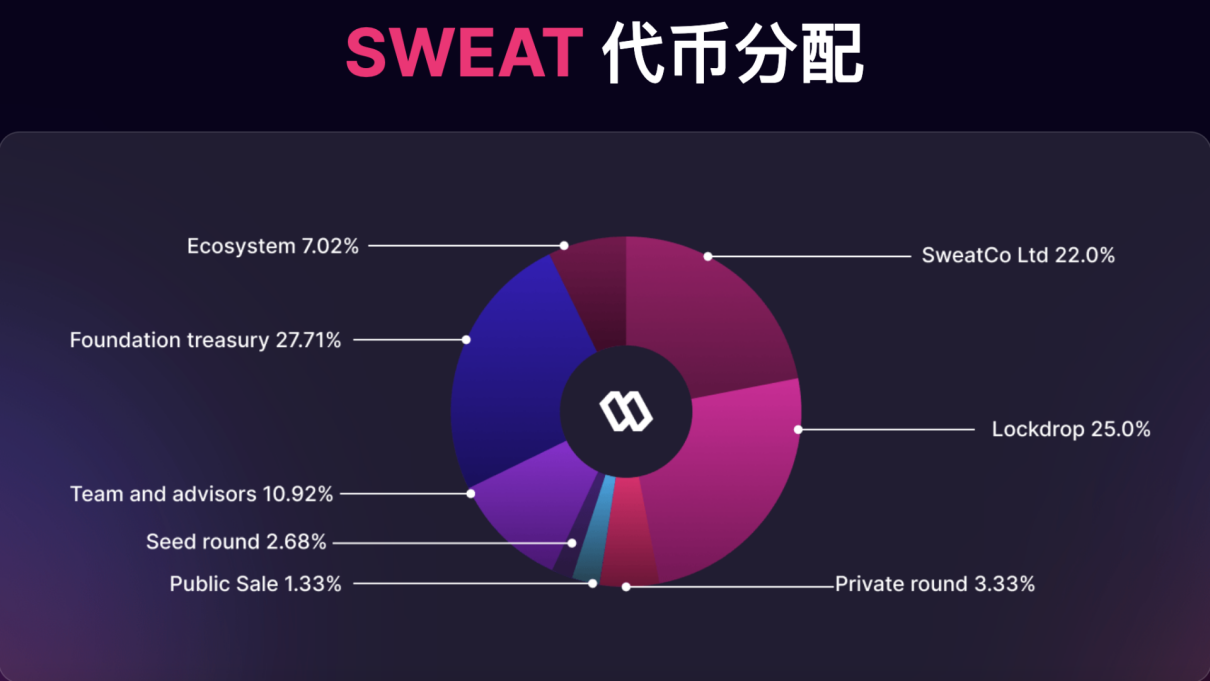
To reduce inflation, the team has designed a minting difficulty for the portion of tokens generated by users walking. This year, 1 Sweat will be produced for every 1,000 steps; in 2023, it will be 0.33 Sweat for every 1,000 steps; in 2024, it will be 0.19 Sweat for every 1,000 steps; in 2027, it will be 0.06 Sweat for every 1,000 steps; and in 2032, it will be 0.02 Sweat for every 1,000 steps.
According to the release cycle, 2 billion Sweat tokens will be released upon launch, and based on the current price on Coinmarketcap, the circulating market value has reached $100 million. In the current market environment, this circulating market value is relatively high. Moreover, 95% of the tokens released in the early stages come from users walking and exercising, and users eager to arbitrage will create significant selling pressure.
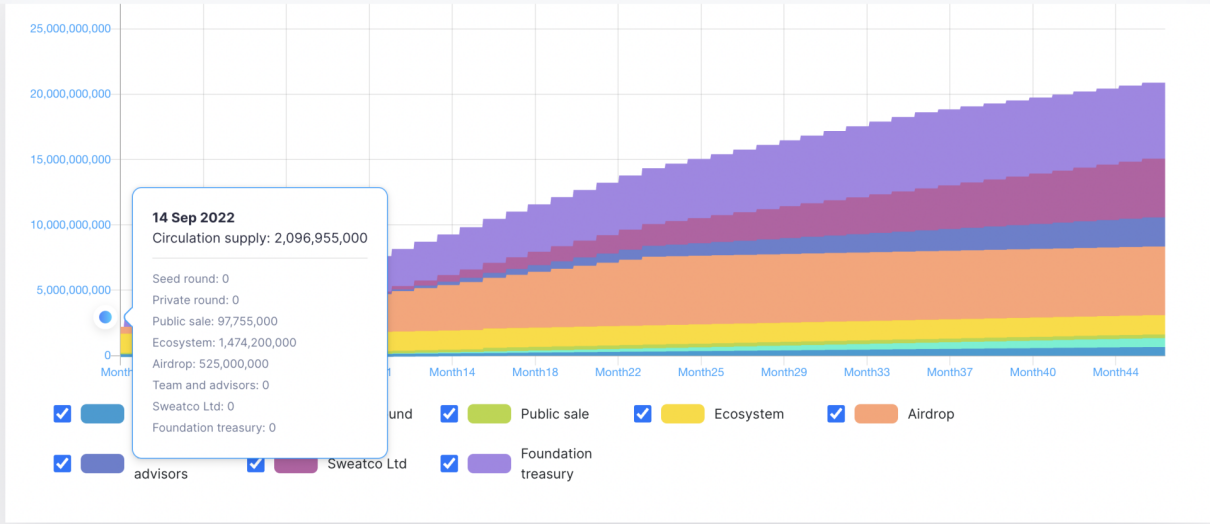
Sweat Generation
Walking to earn tokens: Currently, users can earn 1 Sweat for every 1,000 steps, with a daily double reward available for 20 minutes. It is reported that users can generate Sweat token incentives for the first 10,000 steps each day. Users can increase their limits by purchasing annual or monthly memberships, and a feature to stake Sweat to increase limits will be launched later.
Watching ads to earn tokens: Users can watch ads three times a day to earn between 0.1 to 1,000 Sweat tokens.
Inviting friends to earn tokens: Users can earn 5 Sweat for each successful invitation of a friend.
Uses of Sweat
- Staking
Users can stake SWEAT in the Sweat Wallet to earn high returns and unlock rewards. Rewards will be tiered, meaning the more SWEAT a user stakes, the richer the rewards. For example, coupons and discounts from blue-chip brands like Adidas, Amazon, and Nike, tickets to sports events and concerts, and stablecoins (USDT and USDC).
Staking SWEAT can also unlock special features within the wallet. For instance, users who stake more SWEAT can enjoy lower transaction fees and increase their daily earning limits for walking to earn SWEAT. As the Sweat Wallet application adds more features, staking SWEAT will become increasingly valuable.
- NFTs and Games
The team is building a casual, dynamic NFT game within the Sweat Wallet, set to launch soon. Users can stake SWEAT while playing the game, and winners of game battles can earn the SWEAT staked by their opponents.
- Promotion for businesses or brands
Third-party NFT projects need to pay Sweatcoin in Sweat to list their NFTs; other projects wishing to promote their tokens or NFTs to the Sweat community must pay in Sweat; advertising space within Sweatcoin and the Sweat Wallet requires payment in Sweat.
- Authorization of sports data
SweatDao grants individuals ownership of their data. According to official information from Sweat Economy, user data privacy will not be disclosed to any third parties, and third parties cannot access users' health data. Any institution wishing to access this data must obtain user consent and pay in Sweat.
- Charity activities
Users can initiate charity activities, and Sweat Economy will help users find corresponding donation companies. Additionally, users can donate the Sweat earned during the donation cycle by participating in activity challenges. If the charity activity reaches the required donation amount by the deadline, the funds will be released to the donor.
Profit Model
Advertising fees: Brands, insurance companies, and healthcare providers on the platform pay to engage with Sweatcoin's large user network.
Transaction fees within Sweat Wallet: This includes converting fiat currency to digital currency, trading digital currencies, purchasing NFTs, etc.
Use of Profits
- Token burning
Sweatcoin will use a specific proportion of the profits mentioned above to repurchase and burn Sweat tokens on the secondary market or distribute them as staking rewards.
- Injecting user rewards
A portion of the profits will be invested in rewards that users genuinely want, such as stablecoins, gift cards, and limited event tickets.
- Building the ecosystem
This includes developing project features, growing user communities, and expanding corporate partnerships.
Currently, most X 2 earn projects rely on a funding model where later users take over from relatively early users, categorizing all user actions as DeFi mining. This model leaves little value after a wave of popularity. However, with Sweatcoin's profit and burn models mentioned earlier, we can see that Sweatcoin has introduced external economies early on, forming a closed loop of income and expenditure, attempting to amplify user value and drive the operation of its business model.
Product Experience
Sweatcoin APP
The app has a rating of 4.6 stars on the Apple Store with 290,000 reviews. It has over 50 million downloads on Google, with a rating of 4.4 stars and 1.51 million reviews. Currently, users in countries like China, the United States, Indonesia, and Pakistan cannot use it, but it can be downloaded and used via Google Play and the Apple Store with overseas IDs.
Registration can be done via email or Apple ID, and the process is simple, making it easy for opportunists to exploit the invitation reward channel. However, users do not need to invest any funds to purchase NFTs to start exercising.
The app currently only supports English, operates smoothly without lag, and the usage process aligns with user habits. According to community feedback, there are occasional inaccuracies in step counting, but such instances are rare.
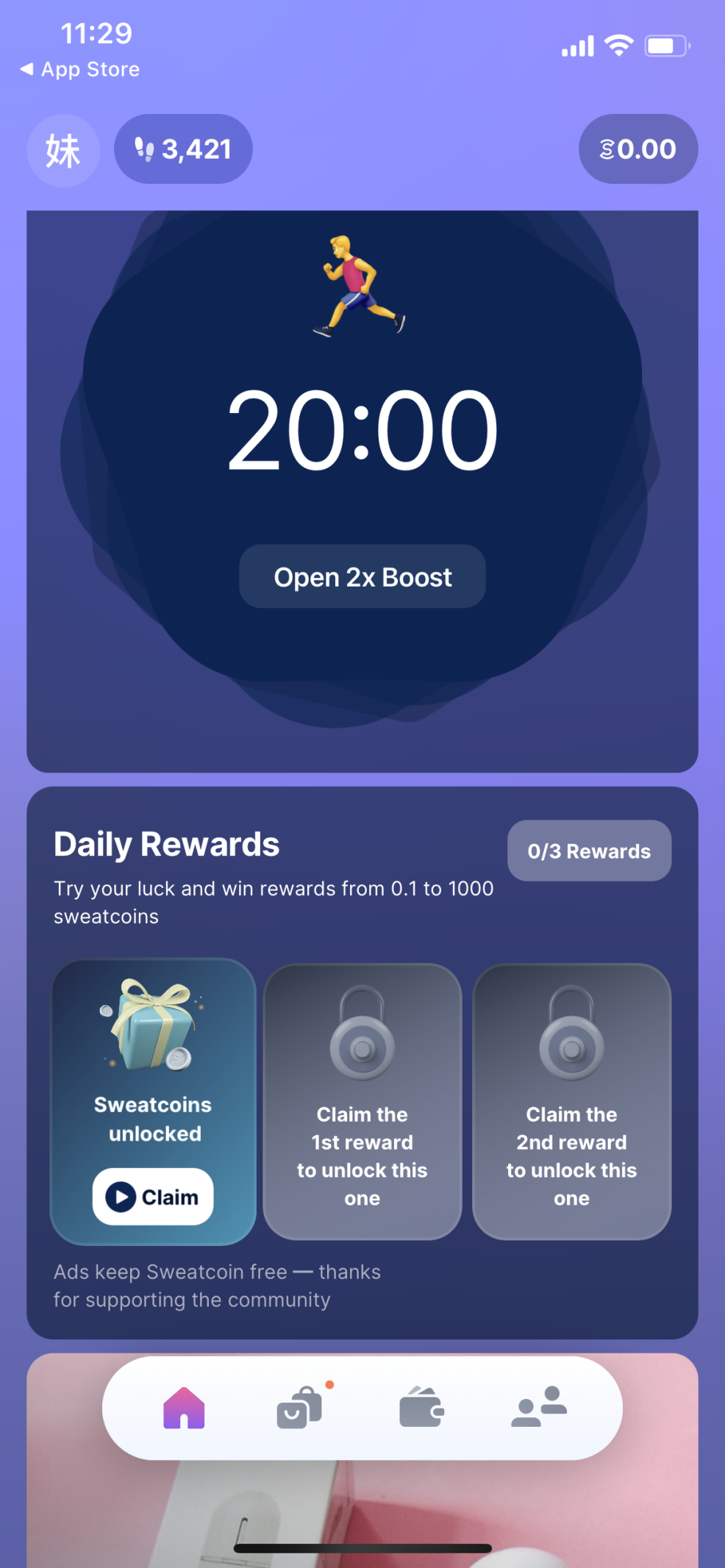
Sweat Wallet
According to official information from Sweatcoin, users have created over 13 million wallets through Sweat Wallet within four months. Currently, the wallet has limited functionality, but features such as buying, selling, trading, staking, and providing liquidity will be gradually launched.
Community
As of September 14, Sweat Economy's Twitter account has 330,000 followers, Discord has 100,000 users, and Sweatcoin's Twitter has 115,000 followers. Sweat Economy is no longer updating and mostly retweets content published by the Sweatcoin account. Sweatcoin's tweets receive relatively high numbers of comments, retweets, and likes.
Currently, the community has expressed dissatisfaction due to the token launch, as participating users are still unable to claim the tokens they earned in the early stages. There have been no official announcements from the team, and this issue awaits resolution.
Due to regional restrictions on product usage, domestic users face many inconveniences in downloading and using the app, but the community has little related documentation or tutorials to assist newcomers.
Additionally, the low daily earnings have also caused dissatisfaction within the community. From the product's original intention, Sweatcoin aims to encourage more users to start and maintain their fitness routines, with the focus not being on how much profit users can earn. Moreover, before the integration of token incentives, the product already had a large user base.
Future Plans
Currently, Sweat Wallet, SWEAT staking, and staking rewards have been launched. In the fourth quarter of this year, SWEAT NFTs, fiat purchases of SWEAT or other tokens, and additional rewards for staking SWEAT will be introduced. In 2023, SWEAT DAO will be launched to practice co-governance and voting schemes, along with the launch of an NFT trading platform and a token trading platform with incentives. In 2024, support will be provided to create a complete sports economy, sports big data analysis, and support for other sports beyond walking, allowing users to earn rewards through activities like cycling and swimming.
In summary, from the perspective of the project and product itself, the Sweatcoin team has rich entrepreneurial experience and a long-term vision. The product has been launched and in the market for eight years, allowing users to enter with zero barriers, and it is currently the most popular health and fitness application. Sweatcoin generates user earnings and rights through advertising revenue from businesses and brands, gradually transitioning from Web2 to Web3, with a simple and closed-loop business model that changes the current "funding model" of similar products.
At the same time, Sweatcoin's associated product, Sweat Wallet, currently has reached 13 million users, serving as an entry point for users into Web3. Sweatcoin can build more scenarios and products through Sweat Wallet, maximizing its business potential.
From an external perspective, Near as a public chain has consistently shown mediocre data, with very few products on-chain that can attract users. On September 12, it was announced that the NEAR Foundation, in collaboration with Caerus Ventures, launched a $100 million venture capital fund focused on investing in seed and Series A stage startups to promote the large-scale adoption of blockchain. Subsequently, Tether announced the launch of USDT on the NEAR network. This strongly indicates Near's official demand for applications that can truly gather a large number of users and funds. As a product with 110 million users based on the Near chain, Sweatcoin should receive maximum support from Near officials from all aspects.
From an investment perspective, it is important to note that Sweatcoin's current circulating market value of $100 million is relatively high, and further observation is needed.
Sweatcoin has value based on movement, and user data holds value, leading to a series of commercializations. Its development model and philosophy provide valuable insights for similar projects in the sector.









